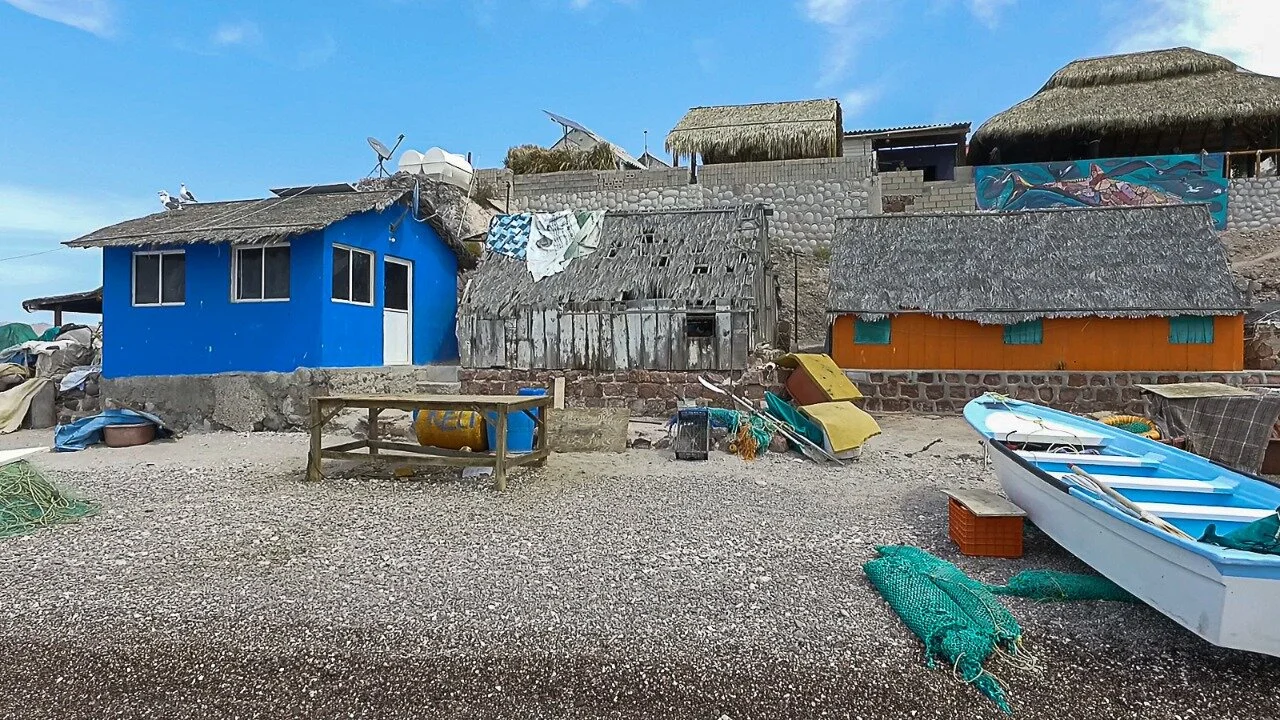A new generation of artisanal fishers in the El Pardito fishing cooperative of Baja California Sur is working to replenish overfished stocks and reduce sea turtle bycatch. El Pardito is an island in the San Cosme corridor, a migration route for manta and mobula rays, whale sharks and other sharks, whales, and five species of sea turtles. Remote and pristine, the corridor offers enticing backcountry adventures for eco-travelers, including those seeking to support conservation of local terrestrial and marine species.
Upwell researcher Stephanie Rousso has seen first-hand the threats posed by artisanal fisheries to sea turtles, mostly by entanglement in gillnets. She also sees an opportunity to work with this new generation of artisanal fishers interested in reducing their impacts on sea turtles. In collaboration with fishers from the El Pardito cooperative, Stephanie is designing a pilot program to measure and reduce sea turtle bycatch. They aim to distinguish seafood products captured without harm to sea turtles, capitalize on unmet local demand for sustainable seafood, and secure price premiums to reward fishers for their conservation efforts.
Stephanie recently convened an interdisciplinary group of stakeholders in El Pardito to discuss the pilot. The group included a gourmet chef, a seafood supply chains expert and an ecotourism company owner; each with a special set of interests and contributions. Stephanie used her training as a biologist to discuss methods for accurately measuring and minimizing sea turtle bycatch. Chef Andrés Hernandez Acevedo expressed his desire to ensure that the seafood he buys does not have a negative impact on the sea turtles his dinner guests came to see on vacation. Silvia Victoria Barradas, owner of Planet Libre Expeditions, said that her American clients frequently ask about the sustainability of the seafood ceviche she serves on snorkeling day trips and lamented that she cannot confidently assure them it was captured without harm to sea turtles. Tj Tate, former Director of Sustainability for Gulf Wild, acknowledged that consumers are willing to pay higher prices for seafood with little to no sea turtle bycatch but cautioned that transparency and traceability systems must be in place to uphold added value.
Photo: Miguel Aguilar
Juan and Felipe Cuevas, two brothers and fishers in the El Pardito cooperative, gave the group a tour in their panga: a 25-foot fishing boat with an outboard motor. The Cuevas brothers have worked alongside conservation scientists since their first days out on the water. They work with Niparajá to help monitor shark reproduction and fish populations in community-designated refuge (i.e., no-take) zones. Eschewing indiscriminate, high-bycatch gear types like gillnets, Juan and Felipe are active participants in the first-ever multi-species Fisheries Improvement Project (FIP) in the Gulf of California, in which 33 target species are caught with only hook and line.
Juan and Felipe shared reflections with the group about their involvement in studies on the population dynamics of critically endangered hawksbills in one of the refuge zones containing mangroves with researchers from Grupo Tortuguero de Las Californias, A.C. and the University of California, Santa Cruz. Together, they have measured, weighed and outfitted 140 critically endangered hawksbill sea turtles with flipper tags. If the team recaptures a turtle already outfitted with a flipper tag, they record data on their growth since the last capture. Some of the turtles are further outfitted with satellite or acoustic tags, which provide information on how hawksbills use mangrove habitat and refuge zones. Luli Martinez, PhD candidate at the University of California, Santa Cruz, says the research has revealed extremely high site fidelity among the tagged hawksbills, thus providing strong justification and validation of the protections in place.
Photo: Miguel Aguilar
Conservation of mangroves and designation of refuge zones can provide ecological benefits to local fishers, but fishers supporting conservation also deserve recognition in the marketplace. Stephanie aims to develop a transparent methodology for artisanal fishers to measure and report sea turtle bycatch. In this way, artisanal fishers can establish baselines, compare bycatch outcomes (with different gear types, seasonal and geographic practices, etc.), and make changes to reduce sea turtle bycatch. Her pilot represents the next logical step beyond existing collaborations with fishers on sea turtle population dynamics and habitat use research.
Although the Cuevas brothers choose to fish by hook and line, many of their counterparts still fish with gillnets. The first phase of the pilot will compare rates of sea turtle bycatch from hook and line fishing to use of gillnets. Juan and Felipe anticipate it will reveal few or no sea turtles caught via hook and line and markedly different results under conventional use of gillnets. This would help them to distinguish their product in the marketplace and secure premium prices from local chefs and ecotourism operators for the seafood they produce via methods aligned with sea turtle conservation. The Cuevas brothers and Upwell also share the goal of enticing more gillnet fishers to switch over to lower bycatch fishing methods, like hook and line. Although similar in concept to the FIP mentioned above, the catch will be directed to local markets rather than exported, thus enabling artisanal fishing communities to share the benefits of investments in local ecosystems.
Upwell’s sea turtle bycatch reduction pilot in El Pardito aims to lay the groundwork for this new generation of artisanal fishers to demonstrate their commitment to sea turtle bycatch reduction. Fishers like the Cuevas brothers need to provide credible and transparent data to secure local price premiums. Chef Andrés Hernandez of La Paz says, “All my clients want seafood when they travel to La Paz. So buying directly from fishers who help protect sea turtles is my goal.” Upwell researchers like Stephanie Rousso are leading efforts to mobilize research data and support economic incentives that drive participation in bycatch reduction and honor the innovation and commitment of the Cuevas brothers and the next generation of artisanal fishers.



